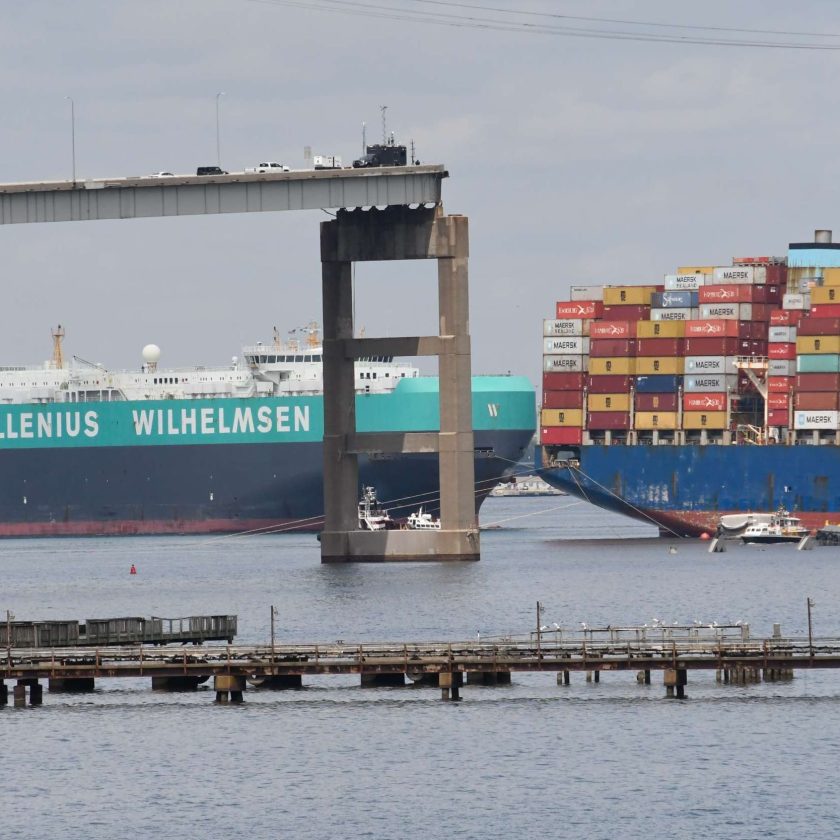1st container ship docks at Baltimore’s Seagirt Terminal since bridge collapse
NewsContainer ships have begun calling at Baltimore’s terminals, one month since the suspension of vessel traffic at the port following the Key bridge collapse.
After a month since the Baltimore bridge collapse, the first commercial vessels have started to move out of the Port of Baltimore via newly opened 35-feet channel.

The first commercial vessels have started to transit through the limited access channel at the Francis Scott Key Bridge site, in conjunction with scheduled passages for a limited number of commercial vessels into and out of the Port of Baltimore, the U.S. Army Corps of Engineers (USACE) said.
The channel, named the Fort McHenry Limited Access Channel, opened on Thursday, April 25 as part of the response effort to the suspension of vessel traffic at the Port of Baltimore, following the collapse of the Key bridge.
The channel has a controlling depth of at least 35 feet (10.6 meters) and provides a crucial route for vessels that have been stranded in the Port of Baltimore following the bridge collapse, offering them a path back to the open waters. It is the fourth alternative channel opened near the wreckage site, and runs the length of the northeast side of the federal channel, providing additional access to commercially essential traffic.

The first vessel to pass the channel was Balsa 94, USACE Baltimore said. Balsa 94 is a general cargo ship built in 2019 and sailing under Panamanian flag. The ship’s registered owner is Eastern Capital Marine from Panama, according to the data from VesselsValue. The ship was guided through the channel by two tugs, and the vessel continued its voyage toward Canada.
The first commercial vessel transited through the Limited Access Channel at the #FSKBridge site Thursday, part of scheduled passages for a limited number of commercial vessels into the @portofbalt and a departure opportunity for deep draft vessels unable to leave the harbor. pic.twitter.com/KsfOffBkme
— USACE Baltimore (@USACEBaltimore) April 25, 2024
Balta 94 was followed by two more ships, including Wallenius Wilhelmsen’s car carrier Carmen, and Saimaagracht, which was the first vessel to successfully move through the temporary channel from the Port of Baltimore’s public terminals.
Another ship heads out today! @WalWil_ASA‘s Carmen successfully moved through the temporary 35-foot deep channel from our Dundalk Marine Terminal this afternoon.
Awesome job @USCG sector Baltimore and @USACEBaltimore. pic.twitter.com/xcBhVeVikC
— Port of Baltimore (@portofbalt) April 25, 2024
Big day in Baltimore!
The Saimaagracht was the first vessel to successfully move through the temporary 35-foot deep channel from the Port of Baltimore’s public terminals. Great work @USCG sector Baltimore and @USACEBaltimore. pic.twitter.com/KwGBuKwFCR
— Port of Baltimore (@portofbalt) April 25, 2024
The Unified Command overseeing the response operation said that starting Monday, April 29, operations to remove the M/V DALI will require suspension of transits through the Fort McHenry Limited Access Channel. Once deemed safe, the channel will reopen for commercial traffic.
“We’re working to strike a balance between enabling temporary access to support commercial activity and undertaking necessary measures to fully reopen the Fort McHenry Channel,” said U.S. Coast Guard Capt. David O’Connell, Captain of the Port and Federal On-Scene Coordinator, Key Bridge Response 2024. “This limited access deep draft channel will provide a window for five of the deep draft vessels currently unable to depart the port as well as some smaller deep draft vessels to transit. Meanwhile, the Unified Command personnel continue to work full speed ahead to safely and efficiently finish operations.”
The Port of Baltimore said that the channel will most likely not be available from April 29 until around May 10.
The three other temporary channels currently in use will remain available and commercial vessels should plan to utilize those channels so not to impede vessel traffic that must use the 35-foot deep channel, the port added.
USACE expects to reopen the Port of Baltimore’s permanent 50-foot deep channel by the end of May.
Meanwhile, the owner and manager of the ill-fated containership MV Dali are facing legal action from the City of Baltimore. The Baltimore mayor and city council accused the two companies of negligence in a court filing earlier this week claiming the vessel was unfit for its voyage, among other things.
By subscribing you will have: